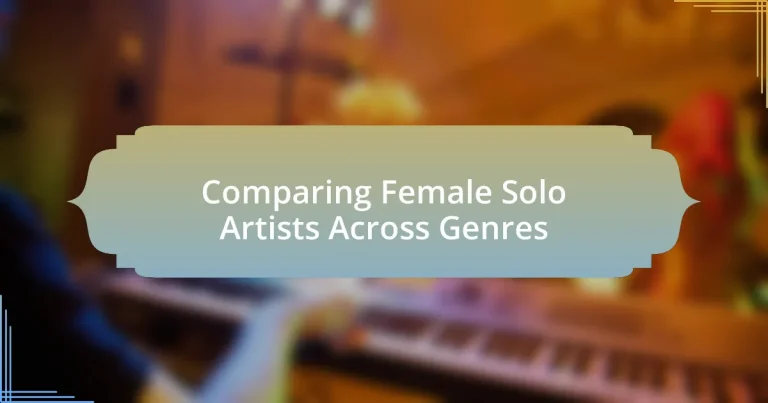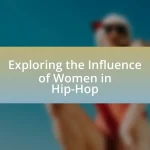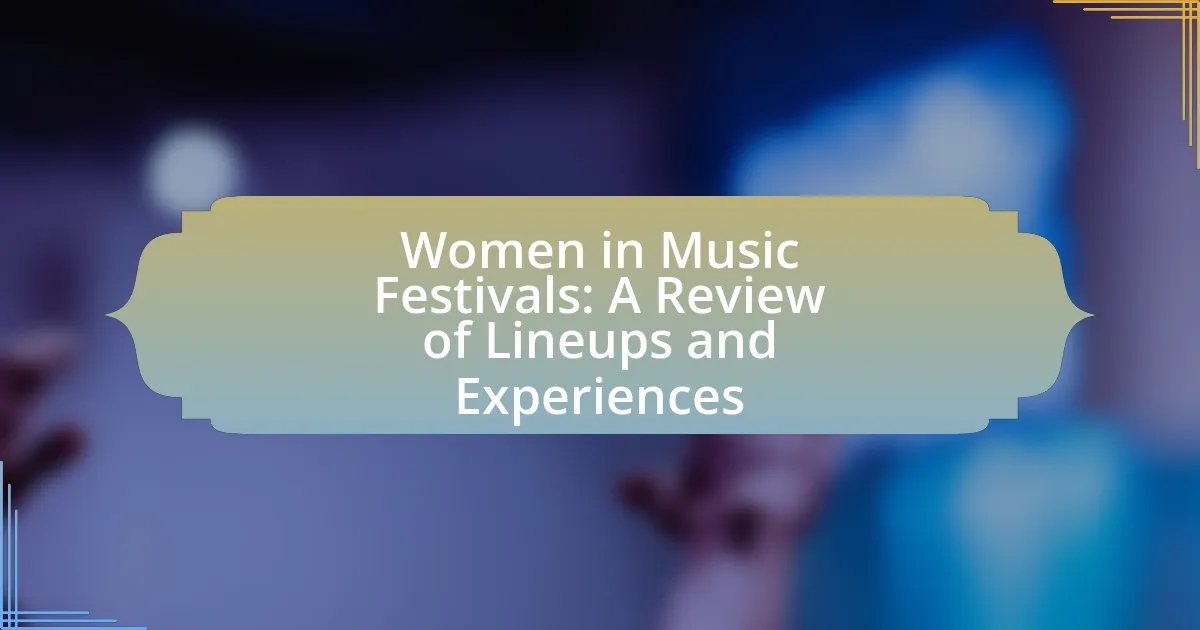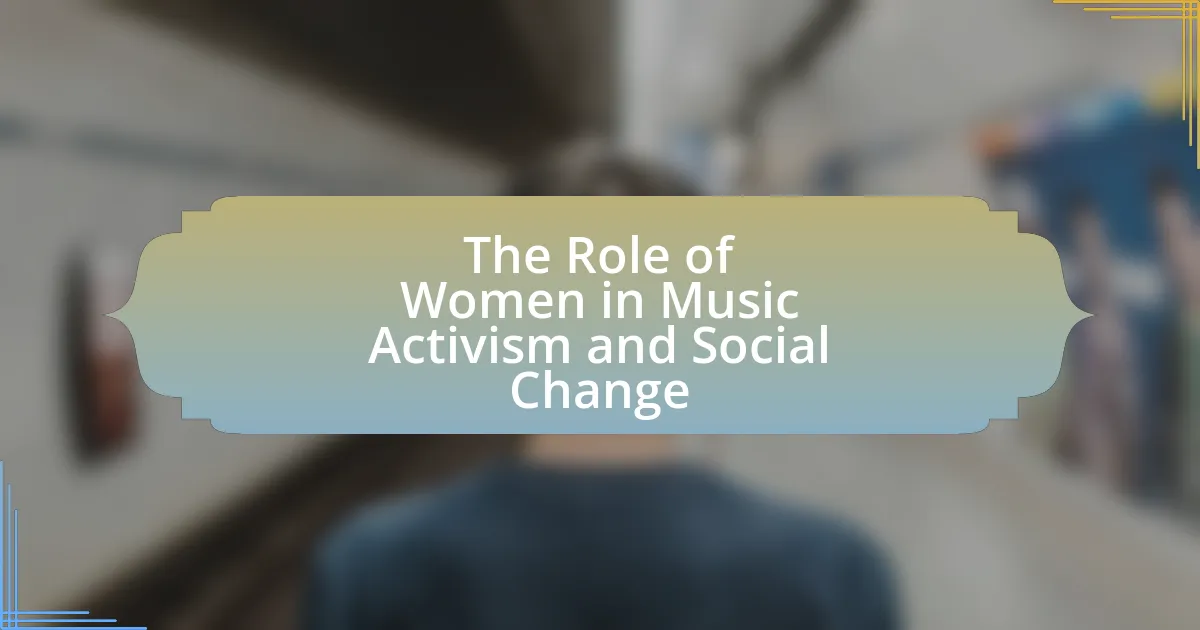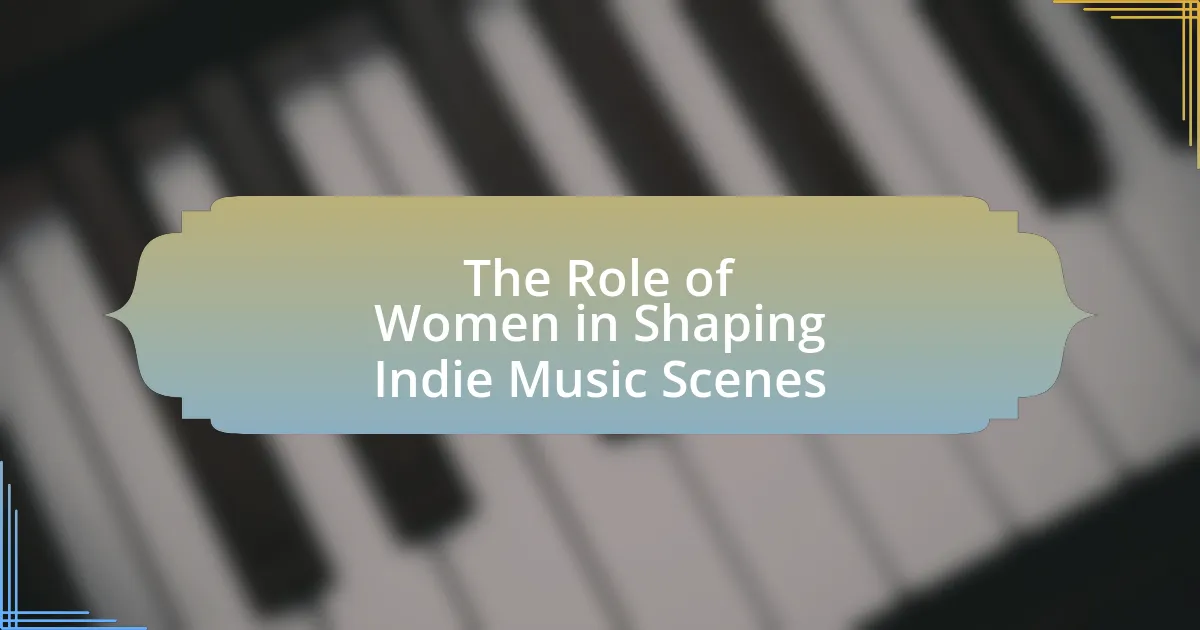The article focuses on comparing female solo artists across various music genres, highlighting their key characteristics, musical styles, and the impact of cultural influences. It examines how individuality, emotional expression, and versatility define these artists, while also addressing the differences in their approaches within pop, rock, and country music. Additionally, the article discusses the evolution of female solo artists over time, the challenges they face in the industry, and the strategies they can employ to overcome these obstacles. It emphasizes the importance of representation, collaboration, and the role of technology and social media in promoting their work.
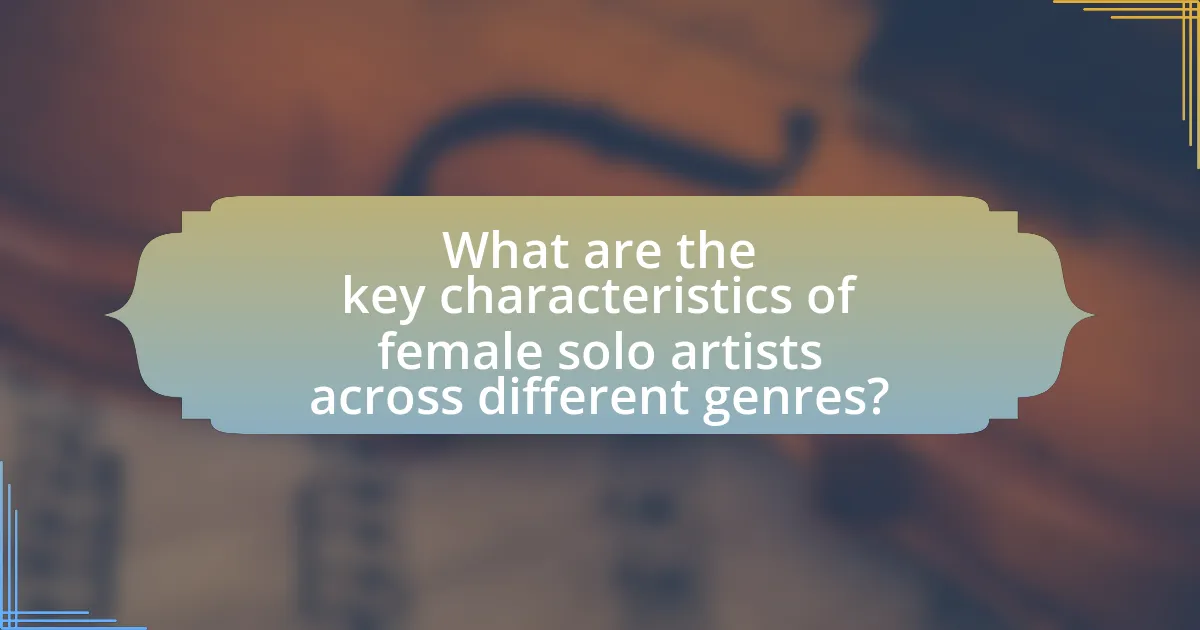
What are the key characteristics of female solo artists across different genres?
Female solo artists across different genres typically exhibit strong individuality, emotional expression, and versatility in their music. Individuality is often reflected in their unique vocal styles and personal songwriting, allowing them to stand out in a crowded industry. Emotional expression is a hallmark of their work, as many female solo artists draw from personal experiences, which resonates with audiences; for example, artists like Adele and Taylor Swift have built careers on deeply personal lyrics. Versatility is also significant, as these artists often explore various musical styles and collaborate across genres, exemplified by artists like Billie Eilish, who blends pop with electronic and alternative influences. These characteristics contribute to their distinct identities and broad appeal in the music industry.
How do female solo artists differ in their musical styles?
Female solo artists differ in their musical styles primarily through genre, lyrical themes, and vocal techniques. For instance, artists like Taylor Swift and Billie Eilish showcase distinct approaches; Swift often blends country and pop with storytelling lyrics, while Eilish incorporates elements of electropop and alternative with introspective and sometimes dark themes. Additionally, vocal techniques vary significantly; for example, Adele is known for her powerful belting, while Norah Jones employs a softer, jazz-influenced style. These differences reflect not only personal artistry but also cultural influences and market trends within the music industry.
What are the defining traits of pop female solo artists?
Pop female solo artists are characterized by their strong vocal abilities, distinct personal branding, and emotional lyrical content. These artists often showcase a wide vocal range and technical skill, which allows them to convey a variety of emotions effectively. Personal branding is crucial, as many pop female solo artists create a unique image that resonates with their audience, often incorporating fashion and visual aesthetics into their performances and music videos. Additionally, the lyrical content frequently explores themes of love, empowerment, and personal struggles, making their music relatable to a broad audience. For instance, artists like Taylor Swift and Adele have achieved commercial success by blending these traits, with Swift’s storytelling and Adele’s emotive ballads exemplifying the defining characteristics of the genre.
How do rock female solo artists express their artistry?
Rock female solo artists express their artistry through a combination of powerful lyrics, distinctive vocal styles, and innovative instrumentation. These artists often draw from personal experiences, societal issues, and emotional themes, which resonate deeply with their audience. For instance, artists like Alanis Morissette and Fiona Apple have utilized confessional songwriting to explore themes of heartbreak and empowerment, while others like Joan Jett and Sheryl Crow have incorporated elements of rebellion and independence into their music. This approach not only showcases their individual perspectives but also contributes to the broader narrative of female empowerment in rock music. The impact of their artistry is evident in the way they challenge traditional gender roles and inspire future generations of musicians.
What unique elements are found in the performances of country female solo artists?
Country female solo artists often incorporate storytelling, emotional authenticity, and strong vocal techniques into their performances. Storytelling is a hallmark of country music, allowing artists to connect with audiences through relatable narratives about love, loss, and life experiences. Emotional authenticity is evident as these artists convey genuine feelings, often drawing from personal experiences, which resonates deeply with listeners. Additionally, strong vocal techniques, including the use of twang and dynamic range, enhance their performances, showcasing their vocal prowess. These elements collectively create a distinctive performance style that sets country female solo artists apart from those in other genres.
What role do cultural influences play in shaping female solo artists?
Cultural influences significantly shape female solo artists by informing their musical styles, lyrical content, and public personas. These influences stem from various sources, including societal norms, historical contexts, and regional traditions, which collectively impact how female artists express their identities and connect with audiences. For instance, artists like Shakira incorporate Latin rhythms and themes reflective of her Colombian heritage, while Billie Eilish draws on contemporary youth culture and personal experiences, showcasing how cultural backgrounds inform artistic choices. Additionally, research indicates that cultural representation in music can enhance relatability and authenticity, as seen in the rise of diverse female artists who resonate with specific cultural narratives, thereby expanding their reach and influence in the music industry.
How do regional music styles impact female solo artists’ sound?
Regional music styles significantly influence female solo artists’ sound by shaping their musical elements, lyrical themes, and performance styles. For instance, a female artist from the Southern United States may incorporate elements of country music, such as storytelling and acoustic instrumentation, while an artist from the Caribbean might blend reggae rhythms and melodic structures into her work. This regional influence is evident in the diverse sounds of artists like Shania Twain, who embodies country music’s roots, and Rihanna, who integrates Caribbean influences into pop and R&B. The distinct cultural backgrounds and musical traditions of these regions provide a framework that informs the artists’ creative choices, resulting in unique sounds that reflect their heritage.
What cultural themes are prevalent in the lyrics of female solo artists?
Cultural themes prevalent in the lyrics of female solo artists include empowerment, love and relationships, identity, and social issues. Empowerment is often expressed through themes of independence and self-confidence, as seen in songs by artists like Beyoncé and Lizzo, who promote self-love and resilience. Love and relationships are frequently explored, with artists like Taylor Swift and Adele delving into the complexities of romance and heartbreak. Identity themes, including gender and sexuality, are prominent in the works of artists such as Halsey and Janelle Monáe, who challenge societal norms and advocate for authenticity. Additionally, social issues like feminism, mental health, and racial equality are addressed in the lyrics of artists like Billie Eilish and Solange, reflecting contemporary cultural conversations. These themes collectively illustrate the diverse experiences and perspectives of female solo artists across genres.
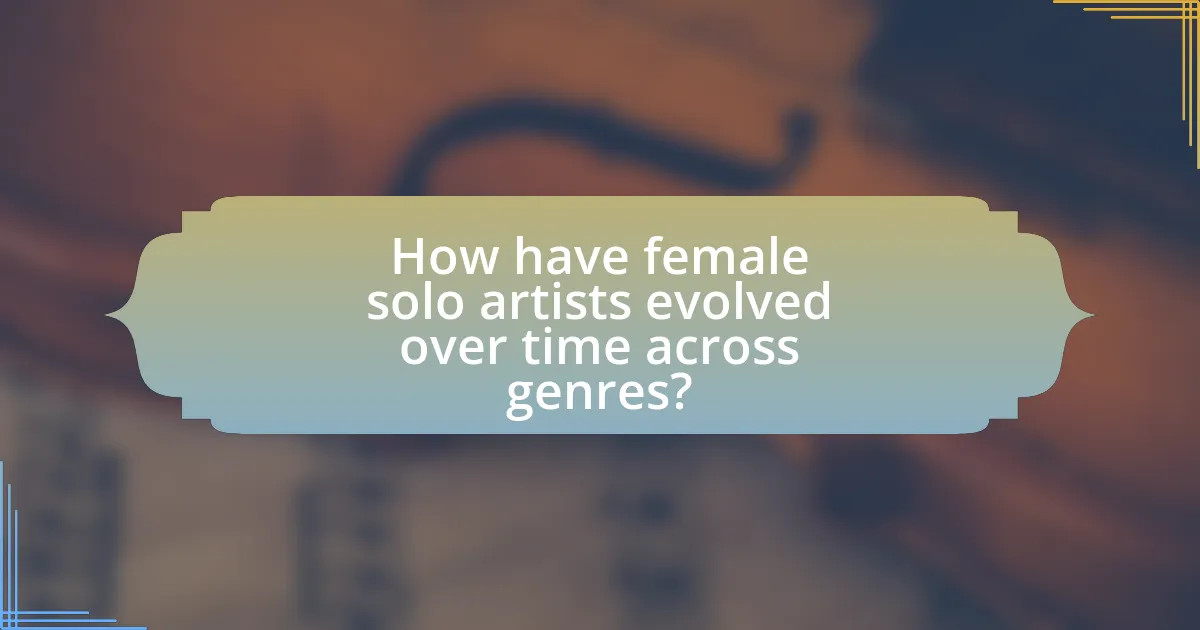
How have female solo artists evolved over time across genres?
Female solo artists have evolved significantly over time across genres, transitioning from traditional roles to diverse representations in contemporary music. In the early 20th century, female artists primarily occupied genres like jazz and blues, with figures such as Bessie Smith and Billie Holiday paving the way for emotional expression and vocal prowess. As the decades progressed, the emergence of rock and pop in the 1960s and 1970s saw artists like Janis Joplin and Aretha Franklin challenge societal norms, asserting their independence and influence.
The 1980s and 1990s introduced a wave of female solo artists in pop and R&B, such as Madonna and Whitney Houston, who utilized media and marketing to redefine femininity and sexuality in music. The rise of hip-hop in the late 1990s and early 2000s brought artists like Missy Elliott and Lauryn Hill, who not only showcased their musical talents but also addressed social issues, further expanding the narrative of female artists.
In the 2010s and beyond, female solo artists have continued to diversify across genres, with artists like Taylor Swift blending country and pop, and Billie Eilish pushing boundaries in alternative music. This evolution reflects broader cultural shifts, including increased representation and empowerment of women in the music industry, as evidenced by the growing number of female headliners at major music festivals and the success of female-led record labels. Overall, the trajectory of female solo artists illustrates a dynamic interplay between genre, societal expectations, and individual expression.
What historical milestones have defined female solo artists in music?
Historical milestones that have defined female solo artists in music include the emergence of influential figures like Billie Holiday in the 1930s, who broke racial barriers and set a precedent for emotional expression in jazz. In the 1960s, artists such as Aretha Franklin and Janis Joplin challenged societal norms, with Franklin’s “Respect” becoming an anthem for both the feminist and civil rights movements. The 1980s saw Madonna redefine female sexuality and empowerment in pop music, while the 1990s brought artists like Alanis Morissette, whose raw lyrics and authenticity resonated with a generation. These milestones illustrate the evolving role of female solo artists, showcasing their impact on music and culture through various genres and eras.
How did the feminist movement influence female solo artists in the 20th century?
The feminist movement significantly influenced female solo artists in the 20th century by empowering them to assert their identities and challenge societal norms. This empowerment led to a surge in female artists expressing their experiences and perspectives through music, often addressing themes of gender equality, sexuality, and personal autonomy. For instance, artists like Joan Baez and Joni Mitchell used their platforms to advocate for social change, reflecting the ideals of the feminist movement in their lyrics and public personas. Additionally, the rise of feminist music festivals and organizations in the 1970s, such as the Women’s Music Festival, provided spaces for female artists to collaborate and gain visibility, further solidifying their impact in the music industry.
What changes have occurred in the representation of female solo artists in the music industry?
The representation of female solo artists in the music industry has significantly increased over the past two decades. In the early 2000s, female artists made up approximately 20% of the Billboard Hot 100 chart, whereas by 2020, this figure rose to nearly 40%. This change is evidenced by the rise of prominent female artists across various genres, such as Taylor Swift in pop and Billie Eilish in alternative music, who have achieved both commercial success and critical acclaim. Additionally, the industry has seen a shift towards more diverse representations, with women of different ethnic backgrounds gaining visibility, as seen with artists like Lizzo and H.E.R. This evolution reflects broader societal changes and a growing recognition of the importance of female voices in music.
How do contemporary female solo artists challenge genre boundaries?
Contemporary female solo artists challenge genre boundaries by blending diverse musical styles and incorporating elements from various genres into their work. For instance, artists like Billie Eilish fuse pop with electronic and alternative influences, while Lizzo combines hip-hop with soul and pop, creating a unique sound that defies traditional categorization. This genre-blending approach not only expands their artistic expression but also attracts a wider audience, as evidenced by Eilish’s multiple Grammy wins and Lizzo’s chart-topping hits. By pushing the limits of genre conventions, these artists redefine what it means to be a musician in today’s music landscape.
What innovative collaborations are emerging among female solo artists across genres?
Innovative collaborations among female solo artists across genres include cross-genre partnerships that blend diverse musical styles, such as pop, hip-hop, and country. For instance, collaborations like the one between Billie Eilish and Rosalía on the song “Lo Vas A Olvidar” showcase a fusion of pop and Latin influences, highlighting the growing trend of artists from different backgrounds coming together to create unique sounds. Additionally, the collaboration between H.E.R. and Chris Stapleton on “Hold Us Together” merges R&B with country, reflecting a broader movement where female artists are breaking genre boundaries to reach wider audiences. These partnerships not only enhance artistic expression but also promote inclusivity and diversity within the music industry.
How are female solo artists using technology to redefine their music?
Female solo artists are using technology to redefine their music by leveraging digital platforms, production tools, and social media to enhance creativity and reach wider audiences. For instance, artists like Billie Eilish utilize home recording setups and software like Logic Pro to produce high-quality music independently, allowing for greater artistic control and innovation. Additionally, the rise of streaming services has enabled female artists to distribute their music globally without traditional gatekeepers, exemplified by the success of artists such as Lizzo and Dua Lipa, who have harnessed platforms like Spotify and TikTok to engage with fans and promote their work effectively. This technological integration not only fosters unique soundscapes but also democratizes the music industry, empowering female artists to carve out their own paths.

What challenges do female solo artists face in the music industry?
Female solo artists face significant challenges in the music industry, including gender bias, lack of representation, and unequal access to opportunities. Research indicates that women are underrepresented in key industry roles, with only 21% of songwriters and 12% of producers being female, which limits their influence and visibility. Additionally, female artists often encounter stereotypes that can affect their marketing and promotion, leading to fewer resources allocated to their projects compared to male counterparts. These systemic barriers contribute to a challenging environment for female solo artists striving for success in a predominantly male-dominated industry.
How does gender inequality manifest in the music industry for female solo artists?
Gender inequality in the music industry for female solo artists manifests primarily through disparities in representation, pay, and opportunities. Female solo artists often face underrepresentation in key industry roles, such as producers and executives, which limits their influence and access to resources. According to a 2021 report by the Annenberg Inclusion Initiative, only 22.4% of artists on the Billboard Hot 100 were women, highlighting significant gender disparity in visibility. Additionally, female solo artists typically earn less than their male counterparts; a study by the UK Music’s “Gender Equality in Music” report found that women in the music industry earn 30% less than men. Furthermore, female artists frequently encounter challenges in securing performance slots at major festivals, with many events showcasing predominantly male lineups. These factors collectively illustrate the systemic barriers that female solo artists face in achieving equality within the music industry.
What barriers do female solo artists encounter in gaining recognition?
Female solo artists encounter significant barriers in gaining recognition, primarily due to gender bias and industry gatekeeping. Research indicates that women are often underrepresented in music production roles, which limits their visibility and influence in the industry. For instance, a study by the Annenberg Inclusion Initiative found that only 22.4% of artists in popular music are female, highlighting systemic inequalities. Additionally, female artists frequently face stereotypes that undermine their artistic credibility, leading to fewer opportunities for promotion and support compared to their male counterparts. These factors collectively hinder their ability to achieve recognition in a competitive landscape.
How do societal expectations impact the careers of female solo artists?
Societal expectations significantly impact the careers of female solo artists by imposing gender norms that influence their artistic expression and marketability. These expectations often dictate how female artists should present themselves, leading to pressure to conform to specific images or behaviors that align with traditional femininity. For instance, research indicates that female artists are frequently judged more harshly than their male counterparts regarding their appearance and personal lives, which can affect their public reception and commercial success. A study published in the Journal of Popular Music Studies highlights that female musicians often face a double standard, where their talent is overshadowed by societal focus on their looks and relationships, ultimately limiting their creative freedom and career opportunities.
What strategies can female solo artists employ to overcome these challenges?
Female solo artists can employ several strategies to overcome challenges in the music industry, including building a strong personal brand, leveraging social media for audience engagement, and seeking mentorship from established artists. A strong personal brand helps female artists differentiate themselves in a competitive market, as evidenced by successful artists like Billie Eilish, who cultivated a unique image that resonates with her audience. Utilizing social media platforms allows for direct interaction with fans, which can enhance loyalty and support; for instance, artists like Lizzo have effectively used platforms like Instagram to connect with their followers and promote their work. Additionally, seeking mentorship can provide valuable insights and guidance, as demonstrated by artists who have benefited from the experience of others in navigating industry challenges. These strategies collectively empower female solo artists to navigate obstacles and achieve success in their careers.
How can networking and collaboration enhance opportunities for female solo artists?
Networking and collaboration can significantly enhance opportunities for female solo artists by providing access to resources, audiences, and industry connections. Through networking, female artists can build relationships with other musicians, producers, and industry professionals, which can lead to collaborative projects that amplify their visibility. For instance, collaborations can result in shared fan bases, increased promotional efforts, and opportunities for performances that might not be available to solo artists working independently.
Research indicates that women in music often face barriers to entry, and collaboration can help mitigate these challenges by fostering supportive environments and mentorship opportunities. A study by the Annenberg Inclusion Initiative found that female artists who collaborate with others are more likely to achieve commercial success and recognition. This evidence underscores the importance of networking and collaboration in creating a more equitable landscape for female solo artists.
What role does social media play in promoting female solo artists?
Social media plays a crucial role in promoting female solo artists by providing them with platforms to reach wider audiences and engage directly with fans. Through channels like Instagram, Twitter, and TikTok, female artists can showcase their music, share personal stories, and build a brand identity, which enhances their visibility in a competitive industry. For instance, a study by the University of Southern California found that artists who actively engage on social media platforms can increase their fan base by up to 30% within a year, demonstrating the effectiveness of these platforms in artist promotion.
What are the best practices for aspiring female solo artists in today’s music landscape?
Aspiring female solo artists in today’s music landscape should focus on building a strong personal brand and leveraging social media for audience engagement. Establishing a unique identity helps differentiate artists in a saturated market, while platforms like Instagram, TikTok, and YouTube allow for direct interaction with fans and the promotion of music. According to a 2021 report by the International Federation of the Phonographic Industry, 50% of music consumers discover new artists through social media, highlighting its importance in modern music marketing. Additionally, collaborating with other artists can expand reach and introduce new audiences, as seen with successful partnerships in the industry.
